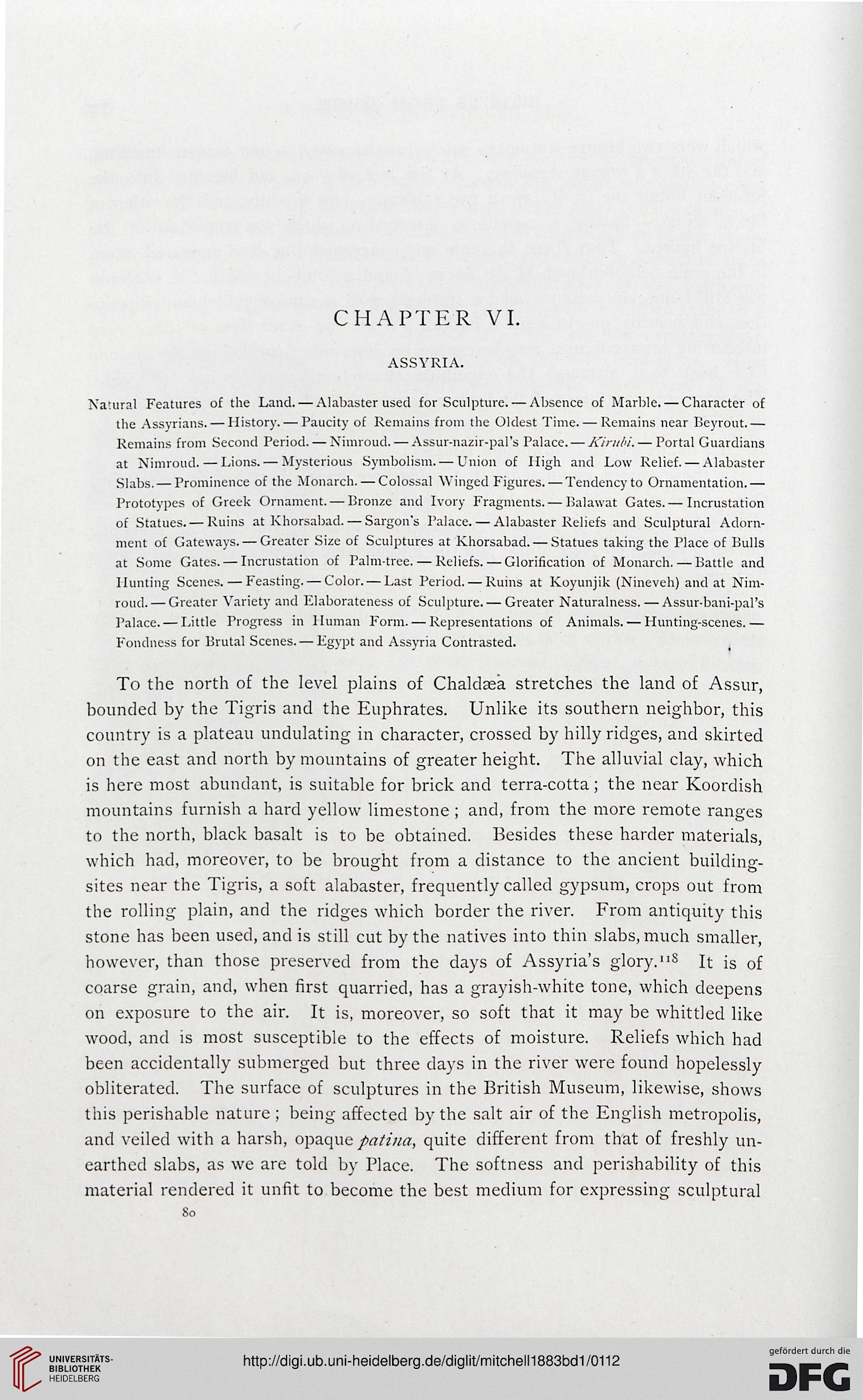CHAPTER VI.
ASSYRIA.
Natural Features of the Land. — Alabaster used for Sculpture. — Absence of Marble. — Character of
the Assyrians. — History. — Paucity of Remains from the Oldest Time. — Remains near Beyrouth —
Remains from Second Period. — Nimroud. — Assur-nazir-pal's Palace. — Kirubi. — Portal Guardians
at Nimroud. — Lions. — Mysterious Symbolism. — Union of High and Low Relief. — Alabaster
Slabs. — Prominence of the Monarch. — Colossal Winged Figures. — Tendency to Ornamentation.—
Prototypes of Greek Ornament. — Bronze and Ivory Fragments. — Balawat Gates.— Incrustation
of Statues.— Ruins at Khorsabad. — Sargon"s Palace. — Alabaster Reliefs and Sculptural Adorn-
ment of Gateways. — Greater Size of Sculptures at Khorsabad. — Statues taking the Place of Bulls
at Some Gates. — Incrustation of Palm-tree. — Reliefs. — Glorification of Monarch. — Battle and
Hunting Scenes. — Feasting. — Color. — Last Period. — Ruins at Koyunjik (Nineveh) and at Nim-
roud.— Greater Variety and Elaborateness of Sculpture. — Greater Naturalness. — Assur-bani-pal's
Palace. — Little Progress in Human Form. — Representations of Animals. — Hunting-scenes.—
Fondness for Brutal Scenes. — Egypt and Assyria Contrasted.
To the north of the level plains of Chaldaea stretches the land of Assur,
bounded by the Tigris and the Euphrates. Unlike its southern neighbor, this
country is a plateau undulating in character, crossed by hilly ridges, and skirted
on the east and north by mountains of greater height. The alluvial clay, which
is here most abundant, is suitable for brick and terra-cotta; the near Koordish
mountains furnish a hard yellow limestone ; and, from the more remote ranges
to the north, black basalt is to be obtained. Besides these harder materials,
which had, moreover, to be brought from a distance to the ancient building-
sites near the Tigris, a soft alabaster, frequently called gypsum, crops out from
the rolling plain, and the ridges which border the river. From antiquity this
stone has been used, and is still cut by the natives into thin slabs, much smaller,
however, than those preserved from the days of Assyria's glory. "s It is of
coarse grain, and, when first quarried, has a grayish-white tone, which deepens
on exposure to the air. It is, moreover, so soft that it may be whittled like
wood, and is most susceptible to the effects of moisture. Reliefs which had
been accidentally submerged but three days in the river were found hopelessly
obliterated. The surface of sculptures in the British Museum, likewise, shows
this perishable nature ; being affected by the salt air of the English metropolis,
and veiled with a harsh, opaque patina, quite different from that of freshly un-
earthed slabs, as we are told by Place. The softness and perishability of this
material rendered it unfit to become the best medium for expressing sculptural
So
ASSYRIA.
Natural Features of the Land. — Alabaster used for Sculpture. — Absence of Marble. — Character of
the Assyrians. — History. — Paucity of Remains from the Oldest Time. — Remains near Beyrouth —
Remains from Second Period. — Nimroud. — Assur-nazir-pal's Palace. — Kirubi. — Portal Guardians
at Nimroud. — Lions. — Mysterious Symbolism. — Union of High and Low Relief. — Alabaster
Slabs. — Prominence of the Monarch. — Colossal Winged Figures. — Tendency to Ornamentation.—
Prototypes of Greek Ornament. — Bronze and Ivory Fragments. — Balawat Gates.— Incrustation
of Statues.— Ruins at Khorsabad. — Sargon"s Palace. — Alabaster Reliefs and Sculptural Adorn-
ment of Gateways. — Greater Size of Sculptures at Khorsabad. — Statues taking the Place of Bulls
at Some Gates. — Incrustation of Palm-tree. — Reliefs. — Glorification of Monarch. — Battle and
Hunting Scenes. — Feasting. — Color. — Last Period. — Ruins at Koyunjik (Nineveh) and at Nim-
roud.— Greater Variety and Elaborateness of Sculpture. — Greater Naturalness. — Assur-bani-pal's
Palace. — Little Progress in Human Form. — Representations of Animals. — Hunting-scenes.—
Fondness for Brutal Scenes. — Egypt and Assyria Contrasted.
To the north of the level plains of Chaldaea stretches the land of Assur,
bounded by the Tigris and the Euphrates. Unlike its southern neighbor, this
country is a plateau undulating in character, crossed by hilly ridges, and skirted
on the east and north by mountains of greater height. The alluvial clay, which
is here most abundant, is suitable for brick and terra-cotta; the near Koordish
mountains furnish a hard yellow limestone ; and, from the more remote ranges
to the north, black basalt is to be obtained. Besides these harder materials,
which had, moreover, to be brought from a distance to the ancient building-
sites near the Tigris, a soft alabaster, frequently called gypsum, crops out from
the rolling plain, and the ridges which border the river. From antiquity this
stone has been used, and is still cut by the natives into thin slabs, much smaller,
however, than those preserved from the days of Assyria's glory. "s It is of
coarse grain, and, when first quarried, has a grayish-white tone, which deepens
on exposure to the air. It is, moreover, so soft that it may be whittled like
wood, and is most susceptible to the effects of moisture. Reliefs which had
been accidentally submerged but three days in the river were found hopelessly
obliterated. The surface of sculptures in the British Museum, likewise, shows
this perishable nature ; being affected by the salt air of the English metropolis,
and veiled with a harsh, opaque patina, quite different from that of freshly un-
earthed slabs, as we are told by Place. The softness and perishability of this
material rendered it unfit to become the best medium for expressing sculptural
So




